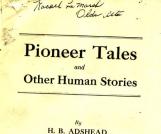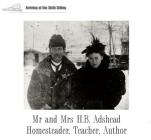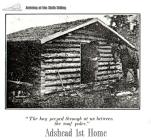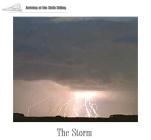1
H.B. Adshead arrives at Olds in 1899. Teacher, author, homesteader.3
A Book written by H.B. Adshead published in 1924. Many of the stories are of his life in Olds.1924
Olds NWT Canada

4
Excerpts from "Pioneer Tales and Other Human Stories" by H.B. Adshead, 1924 Glimpses of the Past,p 29, story of H.B.Adshead.
"In the spring of 1898, Klondike year, I had come to Alberta to teach a summer school for $40 per month, and incidentally to spy out this land of promise ...Arriving in Olds there was a cattle train of seventeen cars of prime Alberta steers being loaded. I met the shipper of the cattle and I learned he was in need of a man to go with the cattle to Montreal. Upon learning I should get a pass back to Olds I applied for the job and asked if I should have time to go back to my boarding house and get some things. "When I want a man, I want him," said the shipper, "and the train leaves in ten minutes on rush orders to catch the boat for England".... and so I found myself in the caboose of a cattle train rushing to Montreal...."
Adshead returned to Olds with his family and continued to teach at the Hainstock School 1898, 99 and 1900. He then taught at the Berrydale School 1901-04 back in 1908 and part of 1909. He later published a book of those days. "Pioneer Tales and Other Human Stories"
We have a number of his stories throughout this exhibit. Some we have dramatized. They are large files but worth the time down loading. Look for "The Storm"
He built a log home on his homestead SW 34-33-2-W5
He tells stories of the awful weather that became known as the wet years.
The day his wife delivered a son was full of drama due to the entire month of Aug it rained, (very unusual and the end of the drought) Creeks became rivers and getting Mrs. Deans to midwife then trekking to find Dr. Kay an American doctor that was a homesteader and didn't have papers to practice in NWT Canada was an adventure.
6
Young School teacher H.B. Adshead brought his young wife from Montreal to their new home near Olds in 1898Excerpts from "Pioneer Tales and Other Human Stories" by H.B. Adshead, 1924 Glimpses of the Past,
p 29, story of H.B.Adshead.
"We were all bundled into a homemade short runner sleigh and away we sped westward.
The shades of night were closing in when we neared the farm and my wife nudged me and whispered, "Where is the house? I don't see any house.
I pointed out the low sod shack, all covered with snow, but it could hardly be discerned, so low and white was it. Do you see that pole straight up in the air?" I asked. "Yes," she said. "Well, that's the pole where Polly, the tame bear, that I played with last summer, was tied," I said.... the house is no bigger than our old pig pen in Ontario. It has no roof and is so low," she said...Inside the shack the stove was red hot with dry poplar wood, and although it was warm and cozy, it was not warmer than the welcome,
...Looking up at the roof we could see the spruce poles with the hay sticking through... Mr. Bame (had a half section about 3 miles north of Adsheads homestead on Sleepy Creek) said, "We couldn't afford cedar shingles, so we had to put on prairie shingles, poles and hay with two rows of sods on top. It keeps the house warm and it takes a good deal of rain before it comes through. Nearly all the shacks of the early settlers were built of spruce logs with poles, hay and sods for the roof.... supper ready. Hot roast meat, brown gravy, mealy potatoes, cottage cheese, Saskatoon pie, and blueberry tarts..."How did you like the meat?"...that was a chunk of young Polly the bear.... we departed to our rooms - beds partitioned by curtains, and although the hay peeped through at us, between the roof poles, and the nor' wester howled at us outside, we felt, on this our first night in Alberta, that "Kind hearts were more than coronets, And simple faith than Norman blood." H.B.Adshead p5-7
8
THE HAIL STORM - "Pioneer Tales and Other Human Stories" 1924 by H.B. Adshead p38Part 1 of 5
Alberta, to the newcomers of '98, in early summer, was a delightful contrast to the rough and crowded East. The rolling prairies bounded only by the horizon and an occasional bluff of poplar trees, were covered with long waving grass and dotted with wild prairie flowers. There bloomed the bleeding hearts, the tiger lilies, the blue bells, the yellow buffalo beans, the violets, the purple peavine, all aglow in the bright sunshine and cloudless sky, making a veritable thick carpet of verdure upon which the contented and sleek cattle lay, and with closed eyes peacefully chewed their cud, while in lazy "Sleepy Creek" the mallard ducks quacked and the little ducklings answered "peep, peep", as they swam to and fro occasionally diving their heads beneath the surface into the mud and grass below, to find a snail or other choice morsel, and at the same time some sentinel drake would stop and lift his head high in the air, if haply he could see some unusualmovement, or hear some warning sound of danger.
Such was the picture the prairies presented in the middle of the afternoon of a hot sultry day towards the end of June, 1899.
Reading by Barry Freeman Desktop Commuications
10
THE HAIL STORM - "Pioneer Tales and Other Human Stories" 1924 by H.B. AdsheadPart 2 of 5
Our garden, and those of our somewhat distant neighbors, were making promising progress. The potatoes were showing signs of coming into flower, the cabbages and cauliflowers had taken good root after transplanting and had lusty stalks, and all promised a good supply for our winter use. In the fields the grain, with its dark green leaves, was beginning to show signs of the shot blade and here and there a plant more adventurous than the rest seemed to lift its long green leaf high into the air, as if seeking for a breath of cool air or a drink of dew. I have often noticed that in a grain field before the short blade appears, on a close hot day a plant here and there would seemingly have a sort of independent voluntary action, and in some unaccountable manner one of its leaves would seem to lift itself into the air apart from all the rest, till I almost thought they had a sort of plant consciousness.
On the sod roof of the log shack, the bold ball mustard, with its yellow flower, drooped somewhat in the still smothering atmosphere, and the very chickens spread out their wings and opened their bills to get a cool breath, while the old mother hen in the coop clucked to her young chickens to come into the shade. Even we humans took the pail at the end of the long well-rope to get a pail of ice water, for down thirty feet the ice of winter had not thawed entirely from the sides of the cribbing. In all this beauty of color and life and amid this stillness and smothering heat, there was among horses and cattle and even ourselves a feeling of uneasiness; some unexplained premonition of coming disaster, and away out on the western horizon there appeared a cloud, at first not bigger than a man's hand, but it swiftly increased in size and blackness and seemed driven by some mighty unseen impelling force. As it rose swiftly above the horizon and began to cover the western sky, it seemed like an evil spirit, and men and horses and cattle turned to look with almost a feeling of foreboding fascination.
Reading by Barry Freeman Desktop Commuications
12
THE HAIL STORM - "Pioneer Tales and Other Human Stories" 1924 by H.B. AdsheadPart 3 of 5
Before the swiftly rolling blackness, there appeared a long rolling white cloud, shaped like a gigantic cigar and from out of the blackness darted sharp forks of lightning, and rumblings of distant thunder came muttering on the air. The rolling blackness, like the chariot of Satan, rolled swiftly onward and now covered the face of the sun. While we gazed at the white rotating cigar, the advance patrol, suddenly there came from the white cloud into the sweltering heat, a blast as if from the Arctic regions, a blast as swift as it was cold, lifting papers, rubbish and boards high into the air and chilling us right to the bone. We all sought shelter in the shack, while horses turned their tails to the oncoming storm. The little chicks ran under their mother's wingin the little hencoop.
Onward came the white rolling infernal cigar-cloud, and it seemed to touch the ground and the blackness grew blacker until the whole sky was blackness when out from the heaven there came a blinding flash, followed immediately by a crash like a battery of artillery at close range. The velocity of the wind increased to a hurricane, the rain came down in torrents, and the second crash brought hail as large as marbles in sheets, the next crash brought devastating hail as large as walnuts, wind-driven with the force of grape - shot out of a cannon, cutting to pieces every living plant in sight and breaking windows wherever it came against them. Again and yet again this terrific bombardment, accompanied by blinding flashes of forked lightning and deafening crashes of thunder, flailed the ground to a pulp, and continued for over half an hour until the ground was white with the hail to a depth of over four inches. The crashes grew less in force and number by degrees, and at last the warm sun came out again and the storm passed on to continue its terrific devastation to other fields, cutting a strip about a mile wide and ten to twelve miles long. Then we ventured out to see what was left.
Reading by Barry Freeman Desktop Commuications
14
THE HAIL STORM - "Pioneer Tales and Other Human Stories" 1924 by H.B. AdsheadPart 4 of 5
While the size of the hail was as small as marbles and as big as walnuts, yet we picked up a few that measured three inches across or nine inches around, made up of five or six smaller stones frozen together in fierce whirling they had undergone in the cloud before striking the ground.
Alas! the poor little chicks in the coop were all either drowned or chilled to death. In the garden, upon which we depended for our winter vegetables, not a potato to be seen, of the cabbages, only a few torn pieces of leaves driven into the ground, and what of the flourishing grain field that but an hour since had proudly lifted its leaves to the sun? Only a black field of earth was left, with nothing on it except a surface indented all over with holes like huge smallpox marks, where the lashing hail had been driven deep into the soil after having cut to pieces the grain so that not a vestige was visible.
And what of the luxuriant prairie grass, with its beautiful colors of wild flowers that spread like a thick carpet over the ground but an hour ago? Nothing left but the top of the prairie sod, not a pound of hay could we cut there now for winter use for our cattle, and walking next day along the edge of "Sleepy Creek," we counted dozens of little dead ducklings floating on the bays of the creek. And the horses came up to the farm with lumps on their back as big as walnuts, where the hail had struck them, and woe betide any settler coming from town, if he were caught with his team in that terrible storm of 1899.
Reading by Barry Freeman Desktop Commuications



